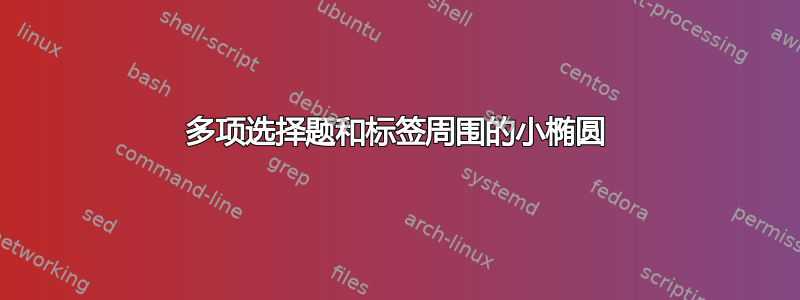
我正在使用“文章”类输入如下的多项选择题:
在 Google 上快速搜索会返回与“考试”类相关的内容。我也尝试了\enumerate一下\itemize。我只得到以下内容
\documentclass{article}
\newcounter{choice}
\renewcommand\thechoice{\Alph{choice}}
\newcommand\choicelabel{(\thechoice)}
\newenvironment{choices}%
{\list{\choicelabel}%
{\usecounter{choice}\def\makelabel##1{\hss\llap{##1}}%
\settowidth{\leftmargin}{W.\hskip\labelsep\hskip 0em}%
\def\choice{%
\item
} % choice
\labelwidth\leftmargin\advance\labelwidth-\labelsep
\topsep=0pt
\partopsep=0pt
}%
}%
{\endlist}
\begin{document}
\section*{No. 2-1}
\subsection*{Section A}
In humans, the pilomotor reflex leads to the response commonly known as goose bumps, and this response is widely considered to be vestigial—that is, something formerly having a greater physiological advantage than at present. It occurs when the
Line tiny muscle at the base of a hair follicle contracts, pulling the hair upright. In animals with feathers, fur, or quills, this creates a layer of insulating warm air or a reason for predators to think twice before attacking. But human hair is too puny to serve these
functions. Goose bumps in humans may, however, have acquired a new role. Like flushing—another thermoregulatory (heat-regulating) mechanism—goose bumps have become linked with emotional responses, notably fear, rage, or the pleasure of, say,
listening to beautiful music. They may thus serve as a signal to others.
\begin{enumerate}
\item The author claims that most studies of folktales told by Afro-American slaves are inadequate because the studies
\begin{choices}
\choice George
\choice Paul
\choice John
\choice Ringo
\choice Socrates
\end{choices}
\item What was the color of George Washinton's white horse?
\begin{choices}
\choice George
\choice Paul
\choice John
\choice Ringo
\choice Socrates
\end{choices}
\end{enumerate}
\end{document}
这使
如何才能使问题标签和选项标签获得如上图所示的相同对齐方式?[编辑以使问题更清晰:] 如何才能摆脱问题标签前的缩进,以便获得与第一张图片相同的布局?- 如何在标签周围画一个椭圆?[添加:我特别感兴趣的是获得与第一张图所示完全相同大小的椭圆。]
答案1
从屏幕截图中测量尺寸相当困难。
\documentclass{article}
\usepackage{enumitem,tikz}
\usetikzlibrary{shapes}
\setlist[enumerate,1]{align=left}
\newlist{choices}{enumerate}{2}
\setlist[choices]{label=\Alph*,format=\ovalnode,align=left}
\newcommand\ovalnode[1]{%
\tikz[baseline=(oval.base)]\node[draw,ellipse,inner ysep=0pt,inner xsep=1pt](oval){\makebox[0.8em]{#1\vphantom{A}}};}
\let\choice\item
\begin{document}
\section*{No. 2-1}
\subsection*{Section A}
In humans, the pilomotor reflex leads to the response commonly known as goose bumps, and this response is widely considered to be vestigial—that is, something formerly having a greater physiological advantage than at present. It occurs when the
Line tiny muscle at the base of a hair follicle contracts, pulling the hair upright. In animals with feathers, fur, or quills, this creates a layer of insulating warm air or a reason for predators to think twice before attacking. But human hair is too puny to serve these
functions. Goose bumps in humans may, however, have acquired a new role. Like flushing—another thermoregulatory (heat-regulating) mechanism—goose bumps have become linked with emotional responses, notably fear, rage, or the pleasure of, say,
listening to beautiful music. They may thus serve as a signal to others.
\begin{enumerate}
\item The author claims that most studies of folktales told by Afro-American slaves are inadequate because the studies
\begin{choices}
\choice George
\choice Paul
\choice John
\choice Ringo
\choice Socrates
\end{choices}
\item What was the color of George Washinton's white horse?
\begin{choices}
\choice George
\choice Paul
\choice John
\choice Ringo
\choice Socrates
\end{choices}
\end{enumerate}
\end{document}
答案2
此代码应该可以完成您想要的操作:
\usepackage{enumitem}
..........
\begin{document}
..........
\begin{enumerate}[wide=0pt, leftmargin=*]
..........





